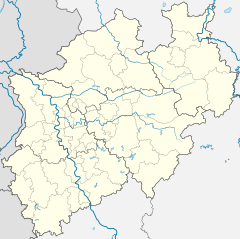Krebsöge train station
| Krebsöge train station | ||
|---|---|---|
|
|
||
| Data | ||
| Platform tracks | 3 | |
| opening | 1886 | |
| Conveyance | 1980 | |
| location | ||
| City / municipality | Radevormwald | |
| Place / district | Crab bugs | |
| country | North Rhine-Westphalia | |
| Country | Germany | |
| Coordinates | 51 ° 11 '48 " N , 7 ° 18' 2" E | |
| Railway lines | ||
|
||
| Railway stations in North Rhine-Westphalia | ||
The station Krebsöge was from 1886 to 1980, the station of the village Krebsöge , today part of the city Radevormwald . With the continuation of the Wuppertal Railway towards Radevormwald, Krebsöge became a separation station .
history
The station was put into operation on February 1, 1886 with the first section of the branch line from Lennep to Beyenburg and was the provisional end point of the line until the next section to Dahlerau was completed on December 1, 1886. With the start of goods traffic to Radevormwald on November 1, 1889, Krebsöge was expanded to become a separation station.
Until the opening of the section to Oberbarmen on February 3, 1890, there were continuous trains from Lennep to Dahlerau or Beyenburg. After that, the through traffic shifted to the Oberbarmen – Radevormwald route. From then on, the trains from Lennep ended in crabs. With the extension of the Wuppertal Railway, there were direct train connections from Oberbarmen via Krebsöge , schlag and Halver to Bruges from 1910 .
Passenger traffic on the Remscheid-Lennep-Krebsöge route was stopped on November 21, 1953. On December 31, 1954, freight traffic to Lennep also ended, the line was shut down and soon dismantled. In the following years, passenger traffic was increasingly thinned out and the station was dismantled into a stop.
From May 28, 1976, the remaining pair of school trains from Oberbarmen, which were driven with a rail bus , already ended in Krebsöge. This connection was also discontinued on December 28, 1979. Freight traffic was maintained until September 26, 1980. In 1982 the last tracks were dismantled. The entire area of the former train station was flooded when the Wuppertalsperre was completed .
Track systems
The station building, the main platform and freight facilities were parallel to the axis of the main track on the Lennep – Dahlerau line (track 1), as was the crossing track (track 2). The route to Radevormwald, built later, branched off in a tight left-hand bend at about the level of the reception building. The facilities of the part of the station, known colloquially as Rader Astes , consisted of an intersection track from which entries and exits in all directions were possible (track 3) and a continuous track for trains from Dahlerau to Radevormwald (track 4). Between these tracks was an island platform, which could be reached from the offset house platform via a pedestrian underpass. Goods tracks 5 to 7 (loading lane, installation track, goods shed) were connected to track 1 via pulling track 8.
From the Rader Branch , the freight tracks could only be reached with extensive shunting trips. For this reason, the main track towards Lennep was excluded from dismantling after the line was closed and remained as access to the freight tracks. The Lenneper Stumpen , as this track was called, ended shortly after the former exit switch at a buffer stop.
Buildings
The station building consisted of a main building with service apartments, an attached goods shed and a side ramp. In the first few years there was a station restaurant in the reception building.
There was also a toilet building on the house platform in the direction of Dahlerau. The covered access to the pedestrian underpass was located between the two buildings. After 1971 the building and its extensions were demolished and a bus shelter was built on the remaining track of the Rader Branch .
For steam locomotives there was the possibility of holding water in crab arches. A small water tower between the branches of the route ensured the supply of feed water. There was a workshop shed near the water tower that was used by the railway maintenance office.
